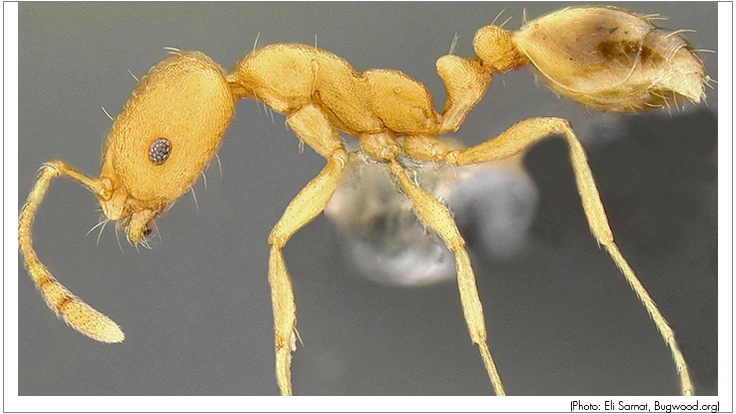
As its name suggests, the pharaoh ant certainly views itself as a “ruler” among ants and they can be a real headache for home and business owners, and the pest management professionals that are tasked with eliminating them.
Unlike other ant species that are easily traced by following visible trails, pharaoh ants do not necessarily follow specific trails when they forage for food and harborage. Combine that with their preference to establish nests in hard-to-reach locations like wall voids, subfloors and attics, and the pharaoh ant is a worthy adversary.
Pharaoh ants are a problem in both commercial and residential accounts. While primarily a nuisance in residential accounts, they can present a health threat in food processing and healthcare facilities, hotels and grocery stores because they can carry and leave behind harmful bacteria (i.e. Salmonella, E. coli) on surfaces they come in contact with.
Pharaoh ants are drawn to commercial facilities because of the warm, humid conditions and abundant food and water sources that are often found inside within commercial kitchens and laundries.
There have been numerous documented cases where pharaoh ants have posed a major threat in healthcare facilities – hospitals, nursing homes and extended care facilities – where they have entered patient wounds and IV bags seeking moisture.
Pharaoh ant colonies are large in size with multiple nests and when they are displaced – sometimes the result of a pesticide application – members will venture off and establish new colonies in a process called budding.
In residential homes, pharaoh ants typically nest near the kitchen including voids under cabinets, behind baseboards and under floors. They also use electrical, cable and telephone wiring as a highway system to travel through walls and between floorboards.
Considering the challenges pharaoh ants present, what are the best methods for combatting them?
John Judge, training specialist for Environmental Pest Services in Tampa, Fla., which manages operations in three different Southern states, says a proper inspection and strategic bait placements are key elements of a pharaoh ant management program.
“The pharaoh ant is not hard to identify but when it splits off during the budding process it can move rapidly and infest the other side of the structure from where you originally found it,” says Judge. “Because of its mobility a technician must look at the whole house rather than just his or her inspection in one area.”
The proper use of inspection tools (i.e. flashlights, probing tools, etc.) and knowledge of construction practices (i.e. identifying connecting walls, location of electrical wiring, etc.) will also help the technician track the source of the infestation and how it got there.
Pharaoh ants found on the outside of the structure should be lured away by the strategic use of baits and repeated treatments may be required to completely eliminate this pesky invader.
Judge says the customer also plays an important part in preventing pharaoh ant by following good sanitation practices.
“Keeping kitchens and food preparation areas clean of spilled food and removing excess moisture and clutter will make those areas less attractive to pharaoh ants,” says Judge. “As with most pest issues securing customer buy-in goes a long way.”
A proactive approach to pharaoh ant management with customers understanding how basic maintenance tasks and adhering to good sanitation practices will help mitigate the problem.
*****************
- Seal all possible points of entry around the house including small openings and cracks around doors and windows
- Keep counters and floors clean and free of crumbs
- Store food in airtight containers and dispose of garbage regularly in sealed receptacles
- Eliminate sources of standing water outside and use a dehumidifier indoors to prevent moisture buildup
- Keep tree branches and shrubbery well-trimmed and away from the house
- Store firewood at least 20 feet away from the house
*****************
The Pharaoh Ant Profile
- Pharaoh ants are very small workers – about a 1/16 of an inch in length
- Coloration ranges from yellow to light brown
- They do not swarm and colonies can number in the hundreds of thousands
- Pharaoh ants can nest indoors and outdoors
- Indoors they will infest hard-to-reach areas including wall voids, subfloors and attics
- Their preferred diet includes sugary foods (syrups, fruit juices, jellies) but they will also eat dead and live insects
Latest from Pest Control Technology
- Donny Oswalt Shares What Makes Termites a 'Tricky' Pest
- Study Finds Fecal Tests Can Reveal Active Termite Infestations
- Peachtree Pest Control Partners with Local Nonprofits to Fight Food Insecurity
- Allergy Technologies, PHA Expand ATAHC Complete Program to Protect 8,500 Homes
- Housecall Pro Hosts '25 Winter Summit Featuring Mike Rowe
- Advanced Education
- Spotted Lanternflies, BMSBs Most Problematic Invasive Pests, Poll Finds
- Ecolab Acquires Guardian Pest Solutions





